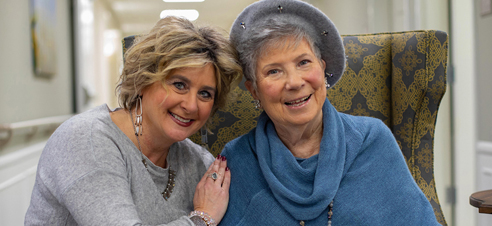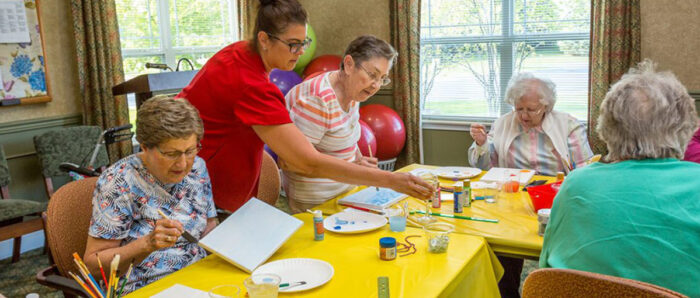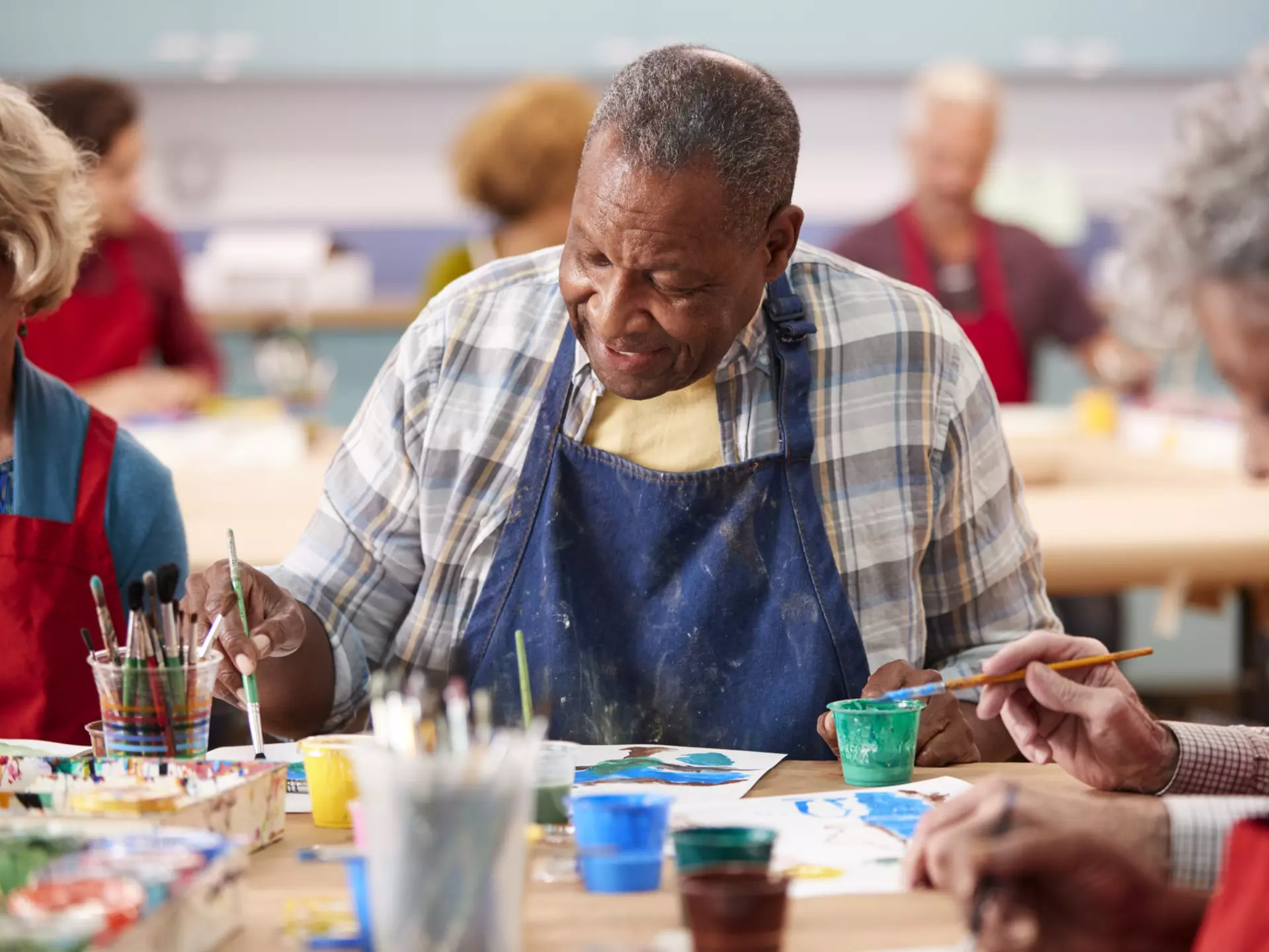Several recent studies have found that engaging in creative pursuits may offer numerous wellness benefits, particularly for seniors. If the idea of tapping into creativity, expressing yourself visually, or even meeting new friends sounds appealing to you, then signing up for an art therapy session could be a good idea.
In this article, we’ll unpack everything you need to know about art therapy for seniors, including its valuable benefits and how to start your or your loved one’s artistic journey.
What Is Art Therapy?
Art therapy is a form of psychotherapy that uses various art forms to help individuals express and process their emotions creatively. Unlike conventional art classes, art therapy sessions are usually led by a professional art therapist who can guide participants in connecting their artwork to their feelings.
The Benefits of Art Therapy for Seniors
Along with being a source of joy and comfort, regularly engaging in art therapy has been shown to provide immense wellness perks, many of which are especially important for seniors.
Some key benefits of art therapy for seniors may include:
- Emotional Well-Being: Sometimes aging can bring emotional challenges, including anxiety about the future, grief over the loss of a loved one, or feelings of loneliness when family lives far away. For many, practicing art therapy activities like painting, drawing, or working with clay offers a safe space to express these emotions and release built-up tension. Studies also suggest that engaging in these creative outlets may boost self-confidence and bring happiness.
- Cognitive Health: As we age, it’s normal to experience some decline in cognitive skills, like focus and mental sharpness. Art therapy offers a gentle and effective way to keep the brain active by stimulating different areas of the brain. According to another recent study, this mental exercise helps maintain or improve key cognitive abilities, like problem-solving and focus.
- Social Connection: Many seniors report feeling lonely or bored after retirement, especially if their family lives far away. Art therapy for older adults can be offered in group sessions, giving seniors plenty of natural opportunities to connect with others as they work on creative projects.
- Physical Benefits: Many seniors deal with stiffness in the hands, reduced coordination, or chronic pain due to age-related changes. Painting, sketching, sculpting, and other art therapies can help improve fine motor skills by keeping your joints flexible and strengthening hand-eye coordination.
Types of Art Therapy Seniors Can Explore
Even if you’re not an accomplished artist, there are many senior-friendly forms of art therapy you or your loved one can try.
Here are some options to explore:
Painting
Painting involves applying paint to different surfaces to help individuals express their unique emotions and ideas visually. The gentle, repetitive movements help strengthen hand muscles and improve hand-eye coordination. In addition, creating pieces of art can also bring a sense of accomplishment and uplift your mood.
Some popular forms include:
- Rock painting
- Finger painting
- Watercolor painting
- Acrylic painting
Drawing
This form of art therapy allows the freedom to create anything without pressure or rules. With total freedom and no set rules, drawing provides a safe space for self-expression, helping improve problem-solving skills and promoting calmness. Sketching or doodling can also gently exercise fine motor skills, which may support memory recall and concentration by engaging multiple areas of the brain.
Consider giving these drawing styles a try:
- Doodling
- Sketching from photos
- Drawing from life
- Abstract line drawing

Sculpture and Clay Work
Another form of art therapy for seniors is sculpture and working with clay. Touching materials with different textures can offer deep sensory feedback that’s grounding and comforting, particularly for individuals living with Alzheimer’s or other types of dementia. The kneading, rolling, and shaping motions may also support joint flexibility and grip strength.
Here are a few fantastic options you might enjoy trying:
- Hand-building with clay
- Wheel throwing
- Making small figurines
- Air-dry clay crafts
Structured Coloring
Structured coloring involves filling in pre-drawn outlines or patterns, like those in adult coloring books, mandalas, or themed pages. Rather than starting from scratch, you add color to shapes, designs, or images already provided. Focusing on coloring inside the lines or following patterns can help improve focus and concentration.
Consider giving these options a try:
- Adult coloring books
- Mandala coloring pages
- Large-print coloring sheets
- Digital coloring apps
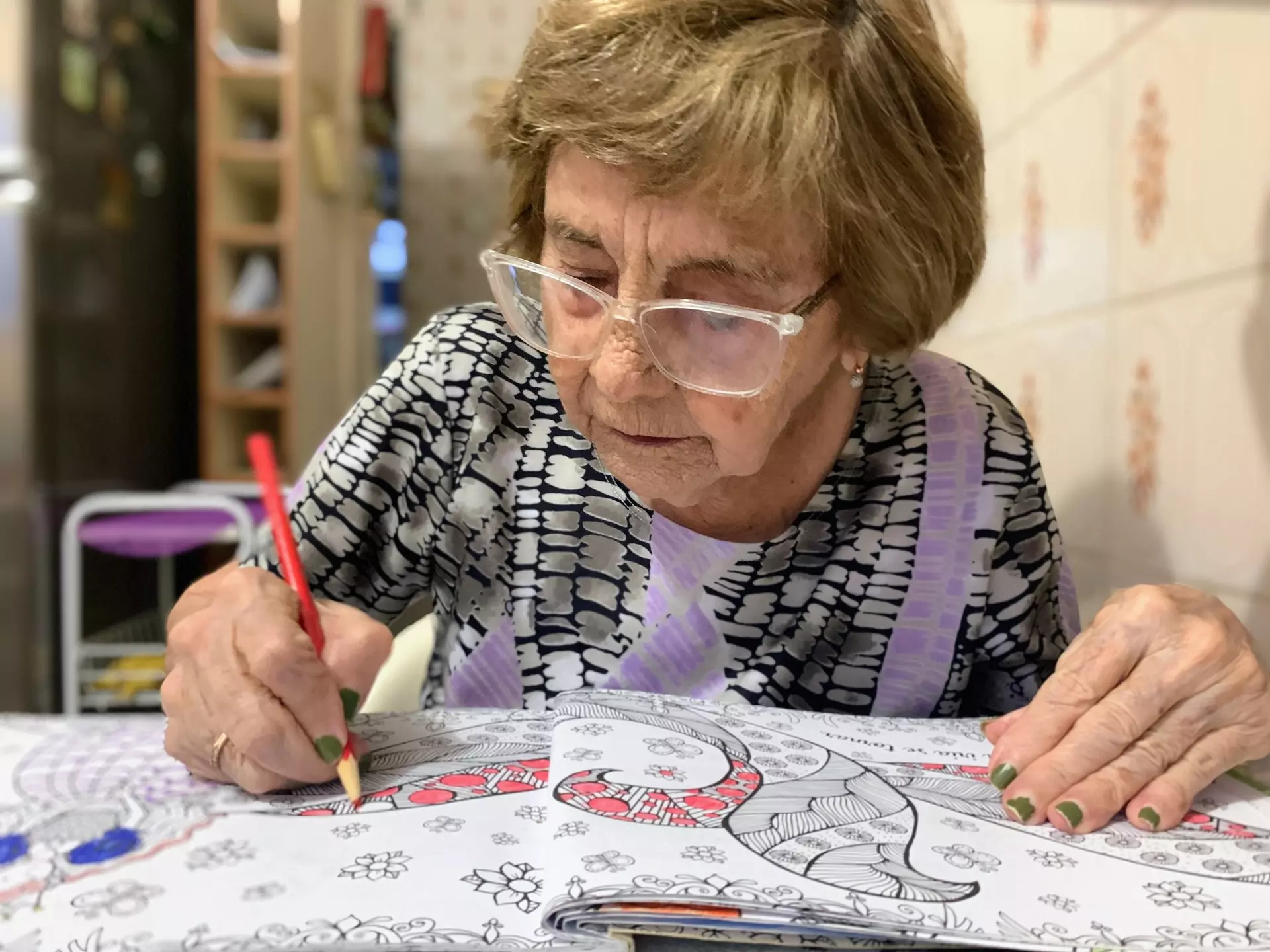
Music Therapy
You might be pleasantly surprised to learn that music is a powerful form of art therapy for seniors! Many studies show that music therapy can reduce anxiety, lift mood, and even improve memory recall in people with dementia.
Some popular options include:
- Group sing-alongs
- Playing percussion instruments
- Guided listening sessions
- Writing simple songs
Textile Arts
Textile arts involve creating decorative or functional items using fabric, yarn, thread, or other fibers. The repeated hand movements, like stitching or knitting, help strengthen finger and hand muscles, which are essential for carrying out activities of daily living (ADLs). Finishing a piece, whether a scarf, pillow, or quilt, can also offer a strong sense of achievement and lift your mood.
Some textile art options to try include:
- Knitting
- Crocheting
- Weaving
- Embroidery
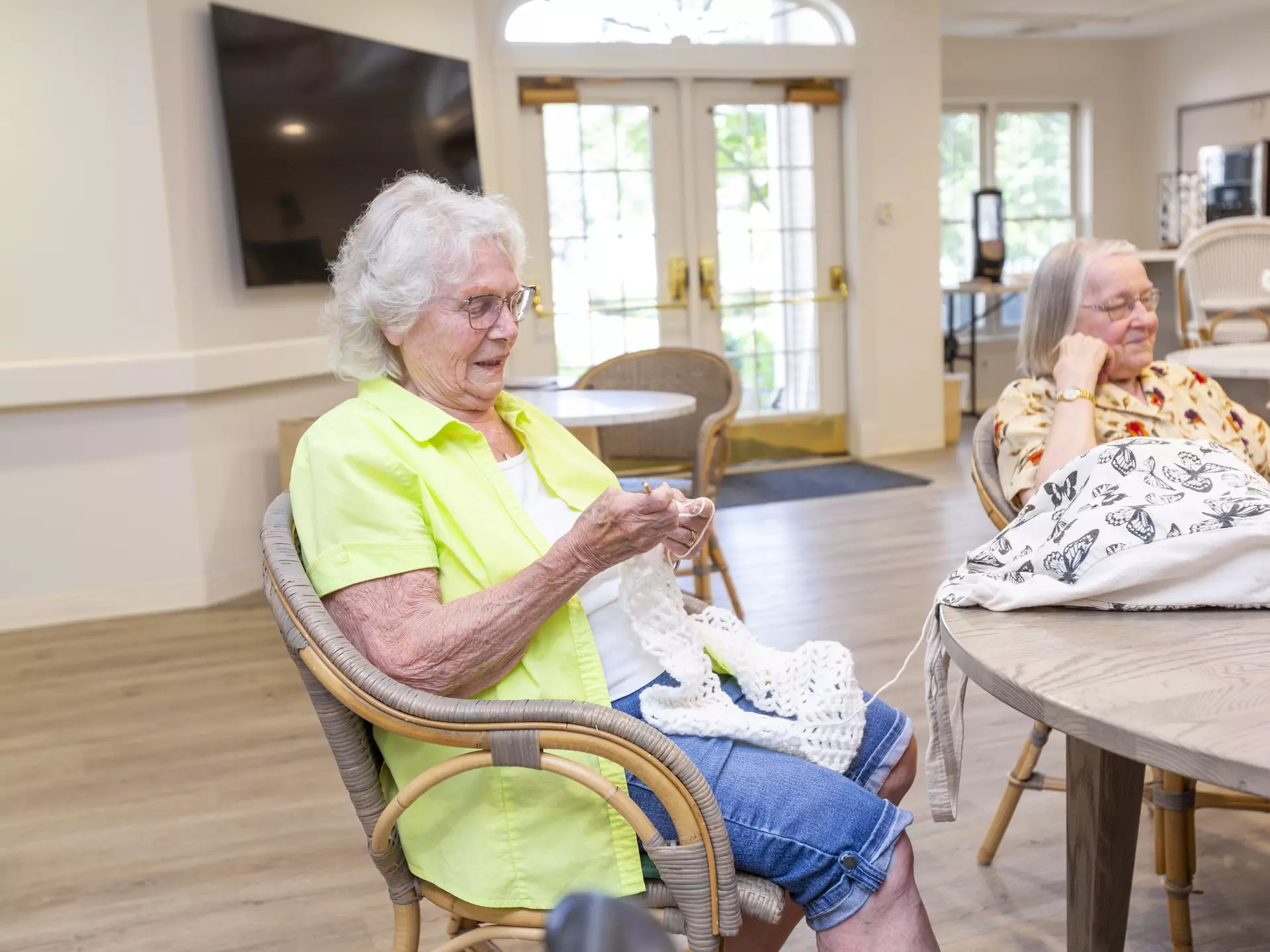
How to Incorporate Art Therapy Into Daily Life
Most forms of art therapy can be adapted to fit different abilities and interests, which means almost everyone can enjoy its wellness benefits.
Here’s how you can add art therapy into your life and make it part of your or your loved one’s routine:
- Join a Senior Living Community: Many senior living communities offer structured art classes led by certified art therapists. If you or your loved one could benefit from group art therapy, consider joining a welcoming community that offers art classes in its activity schedule.
- At Home With Family Caregivers: Some studies have shown that engaging in creative activities with loved ones may provide benefits similar to art therapy. Try picking a few simple projects that match your loved one’s interests and do them together. Sharing these moments of joy can help you feel more connected with your loved one, especially if verbal communication is a challenge.
- Community Programs: Reach out to senior centers, museums, or art studios in your area to see if they offer art therapy for seniors. You’ll likely enjoy learning from professionals, experiencing a change of scenery, and meeting new friends along the way.
Art Therapy and Dementia Care
Art therapy programs, like guided painting, coloring, or working with clay, can stimulate areas of the brain that are crucial for memory and communication. Even if your loved one struggles to recall names or events, they may still respond to familiar shapes, soothing textures, or soft music playing in the background. Over time, art therapy for seniors living with dementia may help slow the progression of certain cognitive symptoms by keeping the brain stimulated, encouraging emotional expression, and strengthening neural pathways that support memory and communication.
As symptoms of memory conditions like dementia progress, your loved one may struggle to communicate their thoughts clearly. This can be frustrating for everyone involved. Art therapy can help create a special space for connection, particularly when words become harder to find. Sitting side by side with your loved one and working on a project together can become a quiet conversation of its own — showing them you’re present with them, even during difficult moments.
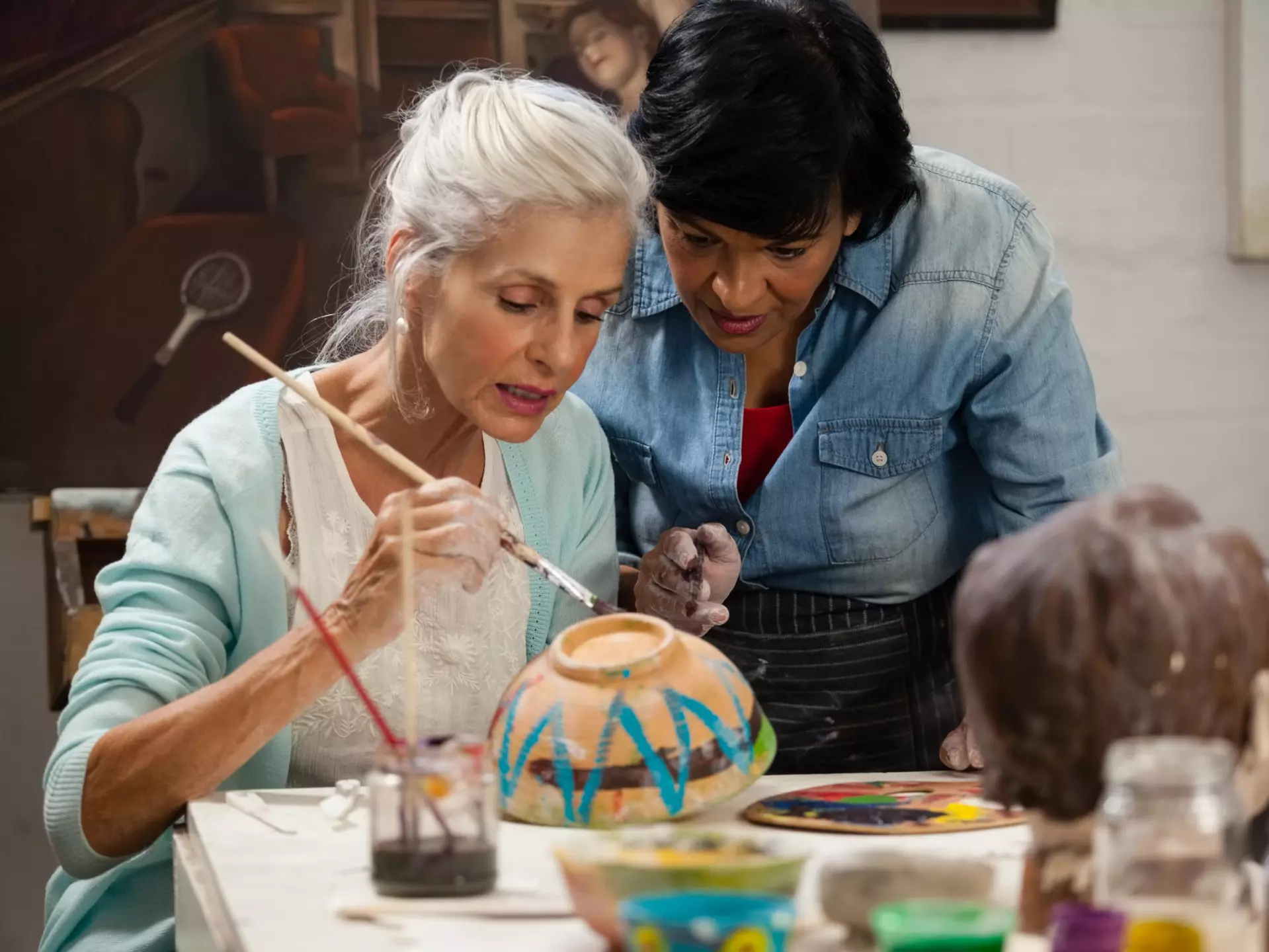
When Art Therapy May Not Be the Right Fit
Although art therapy can provide significant benefits for seniors, it may not be ideal in some situations, including:
- If a senior is highly sensitive to specific textures, smells, or sounds.
- Your loved one often feels overwhelmed or agitated by creative activities.
- Physical limitations like extreme tremors or severe arthritis cause discomfort or pain.
- The senior strongly dislikes creative activities or finds them stressful rather than soothing.
- The person is in an advanced stage of illness and cannot tolerate even short sessions.
How to Get Started With Art Therapy
Whether you’re considering art therapy for yourself or a family member, it’s helpful to know where to look. You can use the American Art Therapy Association’s Art Therapist Locator to locate a therapist in your area. Many therapists also offer virtual sessions if that is more convenient. Your loved one’s doctor can also help connect you with trusted therapists experienced in working with older adults.
When searching for an art therapy program, it’s often helpful to conduct some research to ensure it’ll be able to accommodate your or your family member’s needs.
Below are a few key questions you may ask when weighing your options:
- Is the therapist certified and licensed in art therapy?
- Do they have experience working specifically with older adults?
- Are they trained to work with seniors with cognitive challenges or dementia?
- What types of art therapy activities do they offer?
- Are sessions structured or more open-ended?
- How long is each session, and how frequently are they held?
- Are virtual or in-home sessions available if needed?
- How do they adapt activities for different physical or cognitive abilities?
- How do they handle participants who become frustrated or overwhelmed?
If you’re caring for an aging parent at home, gently encourage them to participate in an art activity they enjoy. It can be helpful to choose times when they feel most comfortable. Often, the key is to offer gentle invitations rather than pressure. Join in when possible to make the sessions more fun and enjoyable for both you and your loved one. Arrange the art space with comfortable seating and easy-to-use materials, and celebrate every accomplishment, no matter how small.
Senior Living With StoryPoint Group Communities
At StoryPoint Group communities, our residents’ needs are at the heart of everything we do. Our goal is to help each person make the most of each day in a way that’s most meaningful to them, and we offer many activities, sometimes including art therapy, to help residents shine.
Whether you’re looking for a relaxed lifestyle with convenient access to amenities and plenty of social opportunities, need additional support with activities of daily living (ADLs), or simply want a place to call home, we’d love to be part of your journey.
To learn more about life with us or just to say hello, feel free to contact us or give us a call at 1-844-275-9990.





